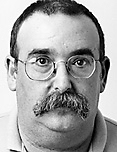



IT wasn't surprising that Kilauea Volcano put on a rare show of 300-foot lava fountains on the Big Island's Puna coast a couple of days after Reggie Okamura died. Reggie Okamura and
Kilauea VolcanoOkamura, the longtime spokesman for the Hawaiian Volcano Observatory, was often heard expressing his respect for Kilauea. With its spectacular bursts of lava at the water's edge Monday, the fiery mountain was just saying, "Back at you, big guy."
In more than 30 years in this business. nothing stands out more than my six years of covering Kilauea as the Star-Bulletin's Big Island correspondent. Learning about the volcano from Okamura made the experience that much richer.
Mainland volcanologists from the U.S. Geological Survey who rotated in and out of Kilauea every few years often had little patience for reporters who didn't immediately grasp the nuances of the earth sciences.
They were awed by the scientific significance of Kilauea, but some of them didn't understand the spiritual power of Kilauea that drew the community -- and news reporters -- back to the volcano eruption after eruption.
Okamura understood. A native of Kau on the Big Island who trained for a career in agriculture at the University of Hawaii, he took a job at the Volcano Observatory just as the mountain unleashed its most spectacular modern eruption at Kilauea Iki in 1959. He was hooked.
Okamura would patiently explain the science you needed to know, but he would also stand with you in wonder of the power of molten rock exploding out of the Earth.
Thinking about Okamura's passing, I was surprised at how many of my most striking reporting memories go back to my days of covering Kilauea more than 20 years ago.
I flashed back to flying low over a remote lava flow in a single-engine airplane, the hot updrafts jerking us around ferociously as I struggled to steady my camera. I was so intent on getting the picture that I completely forgot to be terrified.
I went back to the long hike up Mauna Ulu to check out an eruption, only to find at the top that the area had become so unstable that National Park rangers had taken down the wooden viewing stand at the crater's edge and warned visitors to stay away. Wanting so badly to see the eruption, I got on my hands and knees and crept to the edge to peek at the lava lake below. Stupid, stupid, stupid. That whole side of the crater later collapsed.
I remembered the time a ranger took us through an ohia forest looking for a good view of a new eruption. I got separated from the group and rounded a bend to find myself suddenly on rocky terrain within a few hundred feet of violently churning lava.
MY first impulse was to get the heck out of there fast. My second impulse, which I followed, was to get a little closer for a better angle. I forgave my foolishness when I saw the great photo I got on the front page of the Star-Bulletin the next day.
I'm still chilled by the freezing wind outside the observatory in the middle of the night as I watched an intensely hot curtain of lava fountains dancing in the Kau Desert 10 miles away. I can still feel the moment of panic when I took my eye off a lava flow creeping down the Chain of Craters Road long enough for it to get within a couple of inches of my foot.
My time watching Kilauea was all too short. Reggie Okamura was blessed to take to his grave a lifetime of rich volcanic memories.
David Shapiro is managing editor of the Star-Bulletin.
He can be reached by e-mail at editor@starbulletin.com.
Previous Volcanic Ash columns